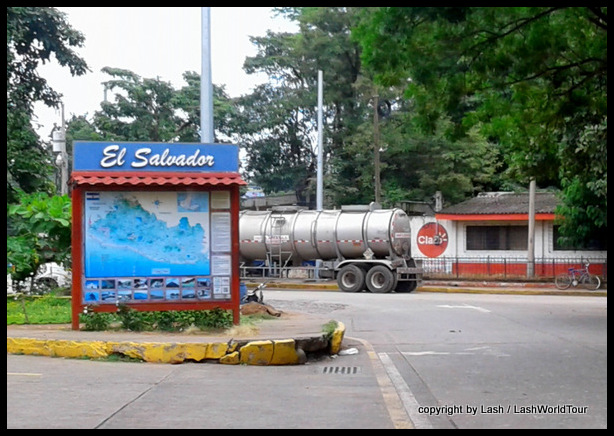
arriving in El Salvador from Guatemala
Introduction to El Salvador
Well, I’m here in El Salvador for the first time in my life! Ta da!
To be exact, I’m in the cute mountain town of Juayua (pronounced ‘why you ah’ because of the Spanish pronunciations of ‘j’ and ‘y’) in western El Salvador. The town is clean, friendly, orderly, cool and…safe, too.
Further more, my hostel is better than most hostels in Guatemala in many ways. It is very spacious, with several big airy rooms, a lush garden and a big kitchen.
It’s really nice to feel spaciousness after the rather tight, cramped hostels in Guatemala. And it’s very nice to have a kitchen. For some reason, Guatemalan hostels don’t have kitchens (which is quite strange for hostels worldwide).
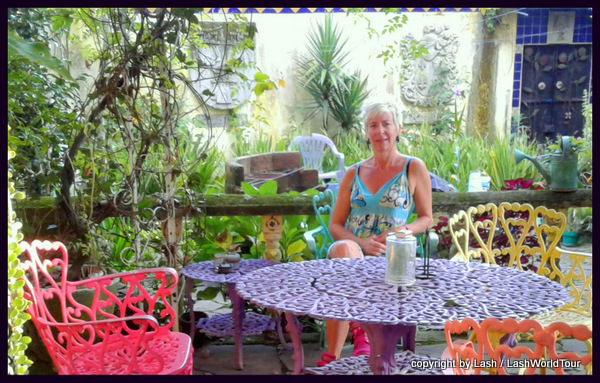
relaxing in the garden at Juayua – El Salvador
My trip here in a tourist shuttle van from Antigua, Guatemala was a breeze. Even the border crossing was fast, easy and efficient. (It cost 160 Q / $22 US.)
Partly that was due to not needing a new visa or entry card for El Salvador. There’s a 4-country visa agreement between Guatemala, El Salvador, Honduras and Nicaragua. Most international arrivals to any of those countries get a 90-day visa good for all four nations.
Upon crossing any of the borders, visitors with the 4-country visa simply need to get their passport stamped out at the departing country’s immigration office and then checked at the arrival country’s immigration office.
In fact, when we arrived to El Salvador immigration point, we didn’t even have to leave the van! The officers checked all our passports from the windows!
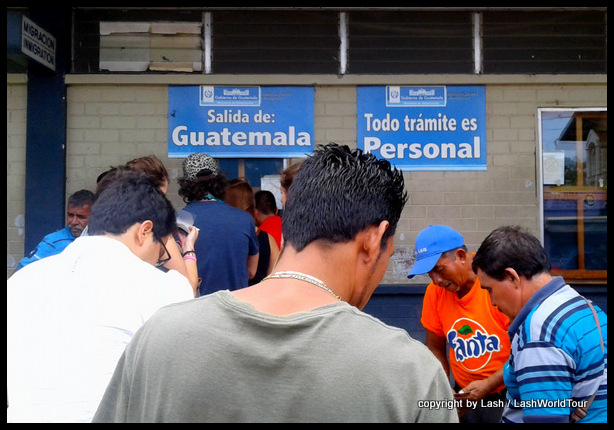
Guatemalan immigration at border with El Salvador
Another reason we had such an easy time is that our van driver crosses that same border day in and day out, at the same time of day, carrying international visitors between the two countries. The immigration officers and police at both country borders knew him on sight. Plus he knew how to drive around the long, long line of cargo trucks waiting to cross the border. Very handy.
That’s a great reason to use the tourist shuttles for border crossings in this region, rather than public buses, which I suspect would make things harder and much more time consuming (hint!).
Meanwhile, here I am, safely ensconced in Juayua. It’s one of the towns on El Salvador’s famous Ruta de Flores / Route of Flowers, which consists of a series of small charming mountain villages and hikes to waterfalls, hot springs and mountain forests.
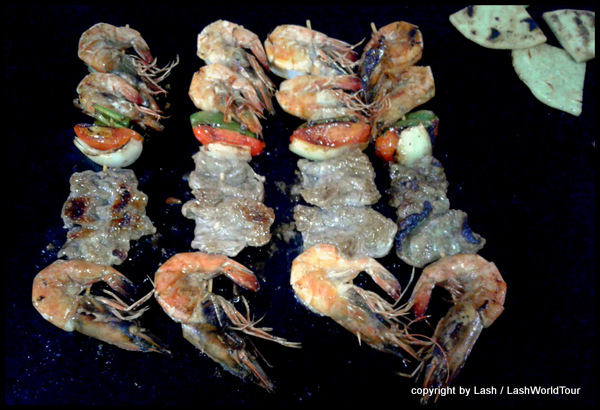
food festival in Juayua – El Salvador
Juayua is particularly famous for it’s weekend food festivals. Booths serve many local specialties as well as gourmet foods and some more exotic dishes like whole grilled frogs, wool-less dwarf sheep (?) and rabbit. I’ll be writing more about my fun culinary ventures here soon.
Meanwhile, the real purpose of this article is to introduce you all to El Salvador itself. So, without further ado, here’s a bunch of informative and useful facts to get you oriented, particularly for anyone interested in traveling through Central America.
More on my personal experiences, recommendations, tips and photographs on El Salvador coming to you over the next month. Stay tuned!
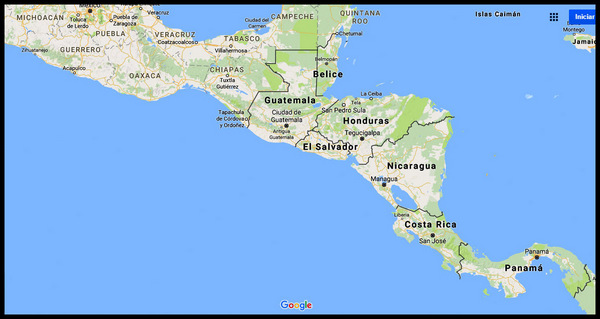 – El Salvador is the smallest of Central America’s seven countries. It’s about the size of New Jersey, half the size of Switzerland. It’s shaped pretty much like Pennsylvania – a long rectangle stretching east to west.
– El Salvador is the smallest of Central America’s seven countries. It’s about the size of New Jersey, half the size of Switzerland. It’s shaped pretty much like Pennsylvania – a long rectangle stretching east to west.
From west to east, the entire country stretches only 300 km / 186 miles and can be driven in 5 hours. North to south it’s only 130 km / 80 miles, but due to mountainous terrain and narrow winding roads, it takes about 3 hours to drive from the Pacific coast at La Libertad to the northern border with Guatemala at tiny border town of Citala.
– It’s also the most densely populated country in the region.
– El Salvador is located right in the middle of Central America, situated on the Pacific Coast side of the narrow Central American isthmus. It’s bordered on the west by Guatemala, on the north and east by Honduras, and on the south by the Pacific Ocean.
– It’s also the only Central American country that doesn’t have a Caribbean coast.
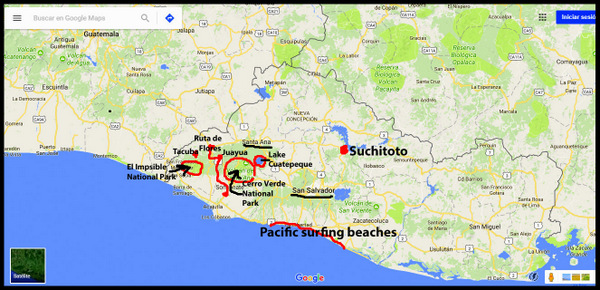
my route through EL Salvador
– El Salvador is a very mountainous country with many volcanoes, crater lakes, dense tropical jungles, mountain villages, historic Spanish towns and wild Pacific surfing beaches.
– In fact, El Salvador is nicknamed ‘Land of Volcanoes’ with 22 volcanoes, some active and some extinct. The country experiences many earthquakes and volcanic eruptions. (Although, I have to point out that neighboring Guatemala has 30 volcanoes, many of them also active. So I’m not quite sure why El Salvador is dubbed Land of Volcanoes, rather than Guatemala).
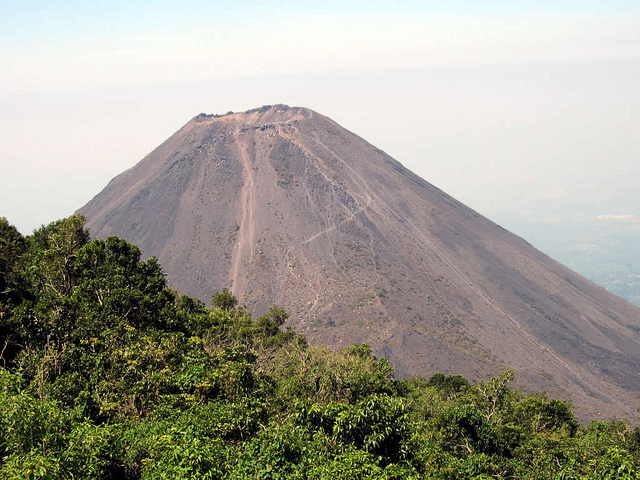
Volcan Izalgo – photo by D-Stanley on Flickr CC
– Like Guatemala and Mexico, El Salvador has several distinct climate and forest zones, including tropical Pacific beaches with dark volcanic sand, cloud forests, tropical forests, volcanoes, pine and deciduous forests.
– It has a hot humid tropical climate year round, with a dry season from Nov to April and a rainy season from May to October. Daytime temperatures are between 28-31 C / 80-90 F, while night time temps are cooler at 15-20 C / 60-70 F.
– The currency is called ‘colon’. At the time of writing, $1 US = 8.75 colones. However, US dollars are generally used instead, with the colon rarely seen in circulation. In any event, $1US = 8.75 is a better exchange rate than for Guatemalan Quetzales, at $1 = 7 Q. Hopefully that means El Salvador will be even cheaper!
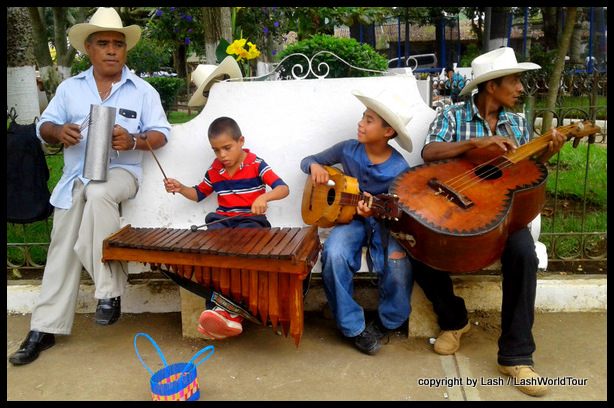
Salvadorean musicians playing in Ataco – El Salvador
– Internationally, many people believe El Salvador is very dangerous country. That’s probably due to its relatively recent civil war that raged from 1980-1992. Adults in the US and Europe who lived through that time, albeit via news from afar, don’t seem to realize that the war is long over and El Salvador has changed greatly since that time.
In fact, since the war ended 25 years ago, gradually more and more tourists have been venturing to this beautiful mountainous country. Most report encountering very friendly people with a laid-back way of life, fantastic Pacific surfing beaches, beautiful crater lakes and volcanoes, stunning scenery and pretty mountain villages.
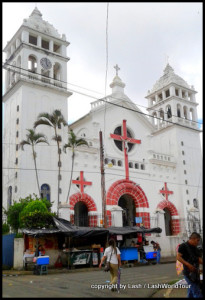
church in Juayua – El Salvador
Another factor is the rather recent advent of drug gangs, primarily in the big cities, which are constantly recruiting young Salvadorians into their gangs. As a result of this, many young boys/teens flee the country in order to escape that dangerous lifestyle.
Luckily for tourists, the drug gangs don’t target foreigners, so it’s very unlikely any western visitors would encounter any problems.
I’ve only been here a few days. So I can’t comment on most of this from first hand experience. But thus far, I’ve found the people friendly, the roads in good condition, the towns clean and attractive, the scenery very pretty and the food tasty, easy to find and very inexpensive. More on all this coming soon!
You might also find the following articles useful:
Preparing to Travel in El Salvador
My Travel Itinerary for Central America
My Route through Central Mexico and Pacific Coast
================================================================







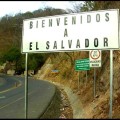
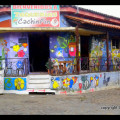
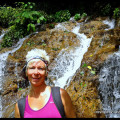
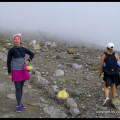

 Hi! I'm Lash, an American nomadic world traveler who's been traveling solo since 1998. I’m passionate about traveling the world nomadically and then sharing it all with you. I hope to inspire you to travel the world, to entertain you with tales from the road, and to help you reach your travel dreams. Welcome!
Hi! I'm Lash, an American nomadic world traveler who's been traveling solo since 1998. I’m passionate about traveling the world nomadically and then sharing it all with you. I hope to inspire you to travel the world, to entertain you with tales from the road, and to help you reach your travel dreams. Welcome! 



